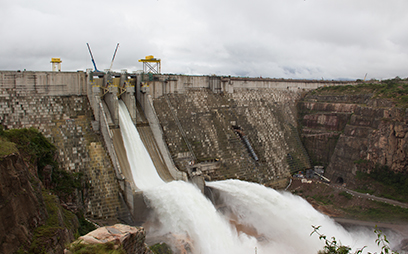 On April 20, the Laúca Hydroelectric Plant flood spillway entered into operation. The event took place eight months after starting to fill the artificial lake – a 188 km² reservoir responsible for holding water from the Kwanza River.
On April 20, the Laúca Hydroelectric Plant flood spillway entered into operation. The event took place eight months after starting to fill the artificial lake – a 188 km² reservoir responsible for holding water from the Kwanza River.
The project is now entering the reservoir water level monitoring phase. This action will take approximately four weeks, depending on the behavior of the Kwanza River tributary flows.
The control process started on April 19 during the flow increase released by the dam bottom spillway, which rose from 60 m³ to 600 m³ per second.
With these two hydraulic elements, the bottom and flood spillways, the level of the artificial lake and maintenance of the ecological flow downstream of the dam can be controlled.
In addition to commissioning tests, the action also aims to maintain the ideal level of water in the artificial lake, which is close to full storage capacity.
Matheus Macedo, the manager responsible for electromechanics, highlighted that the Laúca HA is undergoing a very important phase. “With completion of the artificial lake filling process, the Laúca AH has accumulated a water reserve sufficient to maintain energy production even in the dry period which should take place in the second semester with the cacimbo”. In Angola cacimbo is the name given to the dry season.
The Laúca AH project is a Government of Angola initiative, under the responsibility of the Ministry of Energy and Water (MINEA), supported by the Cabinet of Middle Kwanza River Development (GAMEK) and with construction of the venture by Odebrecht Engineering and Construction. The results obtained are the consequence of extensive investments in training and professional qualification programs in management, engineering and construction, which have involved more than 10,000 workers, including operators, technicians and graduates. 95% of the labor force at Laúca is made up of national staff and more than 13,000 direct jobs have been generated.
On April 20, the Laúca Hydroelectric Plant flood spillway entered into operation. The event took place eight months after starting to fill the artificial lake – a 188 km² reservoir responsible for holding water from the Kwanza River.